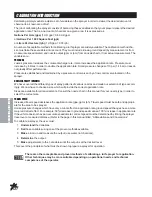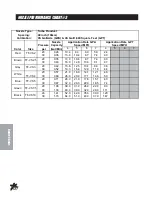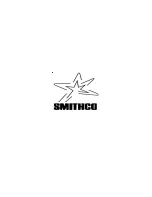
29
Spraying Procedures
NOZZLES
(CONTINUED)
3. Disperse the material in a specific pattern that will
insure even distribution of chemical across the
swath covered by the boom.
As shown (to the right) the pattern formed by flat fan
(TeeJet) nozzles would show most liquid concen-
trated at the center, then tapering off where it begins
to overlap with the next nozzle-approximately
1
/
3
.
The pattern of liquid dispersed by the hollow-cone is
more even across its width. Each nozzle overlaps
the adjoining nozzle by 100%. That is to say the
area covered by each nozzle extends to the center of the two nozzles on either side.
In order to properly develop their spray pattern, each nozzle must be the proper distance from the next
nozzle (spacing) and the proper height above the ground.
NOZZLE SCREENS (STRAINERS)
Smaller nozzles require nozzle screens or strainers to prevent clogging.
• Teejet type nozzles size 8001 and 80015 require 100 mesh screens.
• Teejet type nozzles from size 8002 through 8008 require 50 mesh screens.
• Turbo TurfJet Nozzles Size 1/4 TTJ02-VS and larger do not require strainers.
• Turbo Floodjet Nozzles TF-VS2 through TF-VS3 require 50 mesh screens.
• Turbo Floodjet Nozzles TF-VS4 and larger do not require screens.
SPACING
Turf spray nozzles are normally 20" (51 cm) apart. Some cases 40" (101 cm), depending on the type of spray
boom and type of area to be sprayed.
Very fine, level areas (golf greens and tees, bowling lawns, tennis courts, etc.) may be sprayed with nozzles
spaced every 10" (25 cm).
BOOM HEIGHT
Height is very important in permitting spray nozzles to develop their proper spray pattern. If nozzles are too high,
excessive overlap develops. If nozzles are too low, there is not enough overlapping of nozzle spray patterns.
NOZZLE
NOZZLE
HEIGHT ABOVE
TYPE
SPACING
THE GROUND
80° Flat Fan
20" (51 cm)
18" (45 cm)
65° Flat Fan
20" (51 cm)
12" (30 cm)
Turbo TurfJet
20" (51 cm)
15" (38 cm)
Turbo TurfJet
40" (101 cm)
19" (48 cm)
Turbo Floodjet
20" (51 cm)
16" (41 cm)
Turbo Floodjet
40" (100 cm)
18" (45 cm)
Improper nozzle height or spacing prevents proper application of chemical. Some areas are under treated and
chemicals are ineffective. Some areas are overtreated with wasted chemical and possible turf damage.
Operating your sprayer at a desired speed and pressure on a hard, dry surface is a good method of checking
spraying consistency. Observe nozzles in operation, observe if the area dries evenly. If there are alternating wet
and dry streaks, raise or lower the spray boom. If the wet streaks are directly under the nozzle, the boom is too
low. If the wet streaks are between the nozzles, the boom is too high.
Содержание 3002
Страница 28: ...26 Schematics WIRINGSCHEMATIC HYDRAULICSCHEMATIC ...
Страница 45: ......















































